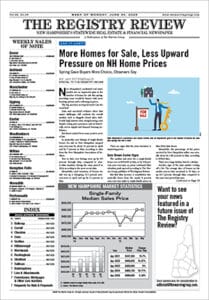
The spring selling season has opened, with a distinct lack of homeowners doing any selling thanks to a Catch-22 involving mortgage rates and a lack of homes for sale. iStock illustration
Real estate experts aren’t expecting a major increase in the number of homes for sale in New Hampshire this spring despite early-year data suggesting an uptick in listings might be in the offing for 2024.
According to the New Hampshire Association of Realtors, new listings of single-family homes on the market jumped year-over-year by 33.9 percent in February, from 646 to 865. Closed sales of single-family homes were also up in February, by 3 percent, from 564 to 581 houses.
Meanwhile, the median single-family home sale price continued its relentless rise in February, rising year-over-year by 9 percent to $440,000, according to data from The Warren Group, the real-estate data firm and publisher of The Registry Review.
Similar listing and pricing trends were seen this past winter in Greater Boston – the largest real estate market New England and one whose dynamics weigh heavily on Southeastern New Hampshire – and across the country, raising hopes that sellers might finally be moving from the sidelines and starting to put their homes up for sale in increasing numbers.
But Adam Dow, chief executive of the Dow Group at Keller Williams Lakes and Mountains Realty, said preliminary March data shows a return to the same old inventory trend of falling numbers of homes for sale in New Hampshire.
Where Once There Were 10K
Even if listings and closings increase a bit in coming weeks and months, the overall number of homes on the market would still be at historic lows, especially compared to the early 2000s, when it wasn’t unusual to see as many as 10,000 or more homes for sale in a spring month, Dow said.
There’s a chance that more sellers might decide to sell their homes this spring or fall, especially if interest rates drop. But it won’t be a dramatic improvement in the inventory picture, Dow said.
“It won’t change things towards a more balanced market,” said Dow. “Inventory will still be down about 90 percent since 2008. We need a lot more inventory to make any sort of major shift in the market.”
Other real estate market-watchers agree: The spring market may see a slight improvement in the number of homes for sale, but it won’t be a dramatic change.
“At this point in the [spring], we should typically be seeing thousands of homes for sale,” said Joanie McIntire, 2024 president of NHAR and an agent at Coldwell Banker-J Hampe Assoc. in Concord. “We should really be at the top of market right now. We’re not seeing that. I don’t see a big change [in the state sales numbers].”
$500K in the Offing?
One thing she does see changing in 2024: Homes prices. And they’re headed upward due to continued high demand and the severely limited number of homes for sale, she said.
Indeed, the median price of a single-family home in New Hampshire could well hit $500,000 or more within the next year, if the current supply-and-demand imbalance continues, McIntire said. And right now, it looks like the current imbalance will continue into the foreseeable future, McIntire said.
As for the February uptick in listings, real estate officials stress that one-month statistical deviations are expected.
They also note that the large percentage increases in February’s listings were coming off small inventory numbers in general, making percentage gains look greater than they really were in absolute numbers.
In addition, industry players also say this past winter’s weather was milder than normal, encouraging some sellers to put their homes up for sale earlier this year than expected.
Two Drivers of Listings Shortage
As for the overall shortage of homes for sale, the short-term problem is tied to sellers balking at selling their homes for two reasons, industry figures say.
First, potential sellers – many of them empty-nesters who might ordinarily have downsized by now – currently own homes with low mortgage rates in the 3 percent range, secured before last year’s rise in interest rates to more than 7 percent.
Though rates for 30-year mortgages have recently fallen to about 6.5 percent, they’re still more than double the rates some homeowners secured years ago on their houses and condos.
Second, many people simply don’t want to sell when there’s so few homes available for them to buy as alternatives.
“Sellers are facing higher mortgage rates and they can’t find new homes to buy anyway,” said Stephan Morrissey, senior broker at Allison James Estates and Homes in Nashua. “Unless they have a critical reason to sell, they aren’t selling.”
In the end, a Catch-22 situation has developed, with potential sellers not selling because not enough people are selling.
Hope for New Production
But the ultimate long-term reason for the inventory shortage is lack of new construction in general, New Hampshire industry players agree.
Morrissey said he’s encouraged that the New Hampshire House of Representatives is pushing local zoning reforms that could spur new affordable home construction, such as allowing homes to be built on smaller lots.
But he said much more has to be done to spark more housing construction.
“We need construction of new affordable housing, but it just doesn’t exist,” he said. “As a result, I don’t see any signs of a major improvement [in inventory]. At best, any improvement will be marginal.”
If interest rates come down later this year, it will likely increase demand for homes – but it won’t impact the sell-side of the equation, he said.
McIntire said today’s high demand for housing has kept real estate agents busy, as they scramble to find available homes for sale and spend more time writing up offers.
“People are really busy out there,” she said. “There are many, many multiple offers. They’re just not making the sales. There’s just not enough inventory out there.”

